ASUS Eee Pad Transformer Review
by Anand Lal Shimpi on April 21, 2011 4:00 AM ESTAn Android Netbook
Extending battery life is one thing, but improving functionality is another benefit entirely. The main problem I had with the iPad's keyboard dock was that it wasn't portable (unless you had a large bag to carry it around in). For the Eee Pad Transformer, this isn't an issue. The dock is designed to mimic a laptop when paired with the tablet, in fact that's why ASUS designed the rear of the Eee Pad to look like the clamshell of a notebook.
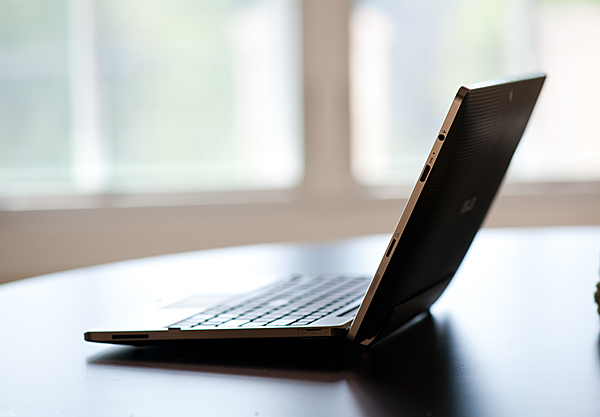
Is that a tablet or are you just happy to see me?
Combine the tablet and dock and you've effectively got a 10.1-inch Android netbook. The dock's hinge is sturdy and travels very smoothly. You can close/open the lid of the docked Eee Pad (which is the Eee Pad itself) just like you would a regular netbook. The Eee Pad even goes to sleep when you close the lid (presumably triggered by the angle of the hinge on the dock).
With the clamshell closed the Eee Pad Transformer is pretty thick, definitely not MacBook Air sized and definitely not a featherweight. The combined setup weighs 2.9 lbs, about right for a netbook but heavy for a tablet. That being said you do effectively have a 48Wh battery in this thing so the weight is excusable.
The dock also adds two USB ports which you can use for USB sticks or external storage and a SD card slot.
Open the clamshell and you'll quickly notice that the marriage isn't purely superficial, the software is also quite accepting. Let's start with the trackpad. There isn't much room for a huge trackpad on the keyboard dock, but ASUS makes do with what little space there is.
Mouse integration works surprisingly well under Honeycomb. It works so well that I actually wonder if Google had planned for enabling Transformer-like docks from the start. Once docked you get a black mouse cursor with a blue halo around it that fits very well within the Honeycomb UI. There are no settings for mouse tracking speed or button configuration, obvious limits imposed by the fact that this is still a touch driven OS, but even without options it's still a good experience.
The left trackpad button acts as your virtual finger: launching apps and activating widgets. You can select text with the trackpad but not via the typical click and drag. Instead you have to double click on a word and then drag the selection widgets that appear:
The right click in Android acts as a back button instead of a way to bring up contextual menus. Its behavior isn't perfectly consistent however. If you've started an app from the home screen (or app launcher), clicking the right mouse button will eventually take you home. If you've launched an app from another one, the right mouse button acts more like a Windows Phone 7 back button than a ticket home. In this case a click or two from the right mouse button will take you to the app you were last using. Given that contextual menus are relegated to the upper right corner of the screen in Android, not forcing the right mouse button to have its more traditional role makes sense.
The trackpad even supports basic gestures. There's tap to click and two finger scroll in both directions. Vertical scrolling is inverted on the trackpad. Swipe two fingers down to scroll up and vice versa, which I grew accustomed to surprisingly quickly. My only real complaint is the feel of moving the cursor takes some getting used to. It's not as good as a PC/Mac experience, but it's not horrible either.
The inclusion of a trackpad is very important, because like I mentioned earlier—no one wants to reach over a keyboard to touch the screen. Quickly switching between typing on a keyboard and using the trackpad is far easier.
The keyboard is similarly surprising. Key travel on the keyboard is excellent. A number of design choices ASUS has made with the Eee Pad Transformer are clearly Apple-inspired, and the keyboard is no different. The feel of the keys on the Transformer dock is near identical to Apple's chiclet keyboard, although there is slightly more resistence on ASUS' version. The individual keys are obviously smaller than on a full sized notebook as you're effectively getting a 10.1-inch netbook with the Transformer. The only keys I had trouble with are those around the right shift key where everything is just cramped together.
ASUS includes a narrow row of function keys at the top of the keyboard. These are supremely useful covering everything from launching the Android web browser to adjusting brightness. It's the Android specific keys that are really the nicest touch. There's a key to toggle automatic brightness control, a key to take you to the Honeycomb settings page, a key to go back, and a key to lock the tablet. ASUS even included a screenshot key. The only thing that's missing is a way to alt+tab through active apps.
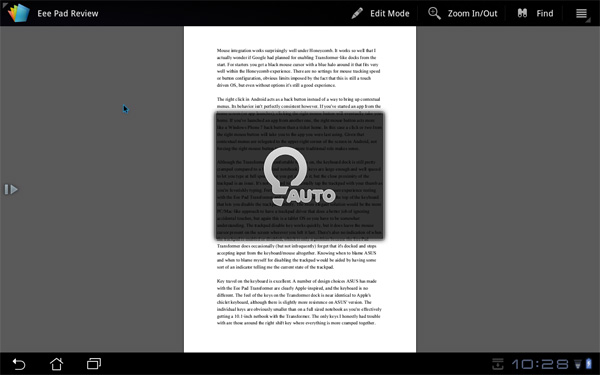
Auto brightness enabled via hotkey
I also found myself hoping for additional app shortcuts on the keyboard. The dedicated browser button is great, but I also wanted one for email. I feel like the right thing to do here would be to offer user customizable buttons to launch various apps.
To the left of the space bar are search, home, and an Fn modifier key in that order. The search key activates the Honeycomb search widget, home takes you home, and we all know what Fn does. To the right of the space bar are alt and a contextual menu key.
Keyboard shortcuts are partially supported under Honeycomb on the Transformer. You can't hold shift and tap the arrow keys to highlight text, but Ctrl + X/C/V do work to cut/copy/paste. Home and End also work. You do have to keep in mind that most apps aren't aware that there's a physical keyboard present and thus you can't do things like hit backspace to delete an email. Navigating within apps using the keyboard's arrow keys does work, but not extremely well—you're much better off using the mouse. The only exception here is the menu key which you can hit and quickly scroll down through available options using the arrow keys.
Although the Transformer is comfortable to type on, the keyboard dock is still pretty cramped compared to a full sized notebook. The keys are large enough and well spaced to let you type at full speed once you get used to it, but the close proximity of the trackpad is an issue. It's not too hard to accidentally tap the trackpad with your thumb as you're feverishly typing. Fortunately, ASUS clearly did some user experience testing with the Eee Pad Transformer and gives you a single hotkey at the top of the keyboard that lets you disable the trackpad entirely. The more elegant solution would be the more PC/Mac-like approach to have a trackpad driver that does a better job of ignoring accidental touches, but again this is a mostly unmodified tablet OS so you have to be somewhat understanding.
The trackpad disable key works quickly, but it does leave the mouse cursor present on the screen wherever you left it last. There's also no indication of when the trackpad is enabled or disabled, which is only a problem because the Eee Pad Transformer does occasionally (but not infrequently) forget that it's docked and stops accepting input from the keyboard/mouse altogether. Knowing when to blame ASUS and when to blame myself for disabling the trackpad would be aided by having some sort of an indicator telling me the current state of the trackpad.

The software side of the keyboard is also interesting. ASUS has a software layer on top of Android that detects the presence of the dock and dutifully instructs you to use the hardware keyboard "to type words". ASUS even provides a toggle to enable/disable the physical keyboard without going to a separate settings page.
With the physical keyboard enabled, the virtual keyboard will never appear—even when you're in an app that requires input from the keyboard.
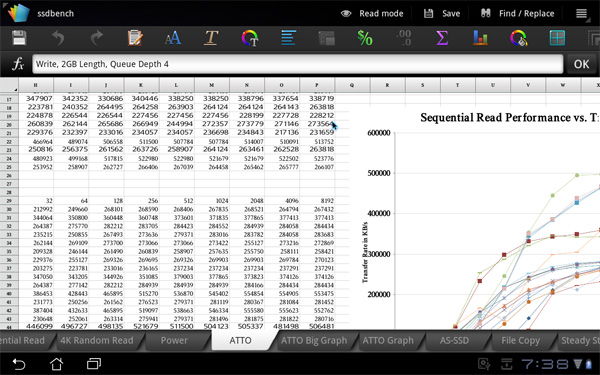
Using the Eee Pad as a netbook, getting work done
The whole experience is remarkably polished. When docked the Eee Pad truly behaves like an Android netbook, and if you find yourself not needing the physical keyboard and trackpad you can easily convert (or transform) the Eee Pad back into a tablet. External storage is even reasonably supported when docked; you can launch File Browser and view what's on external USB drives or SD cards:

You still have the obvious software limitations of Honeycomb (e.g. not all files will open) but it's clear that this approach has potential. All of the sudden NVIDIA's decision to make Kal-El a quad-core part makes sense—if your tablet is going to double as a full blown PC, it might as well have the processing power when you need it.


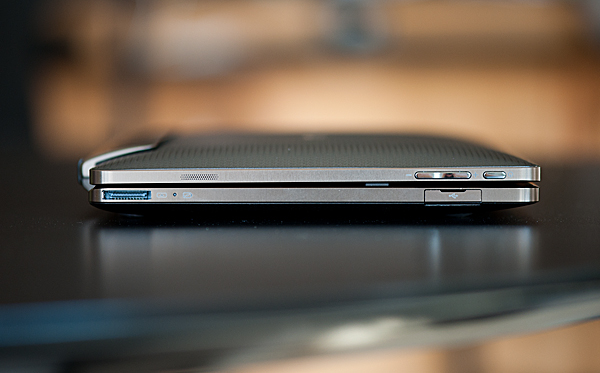
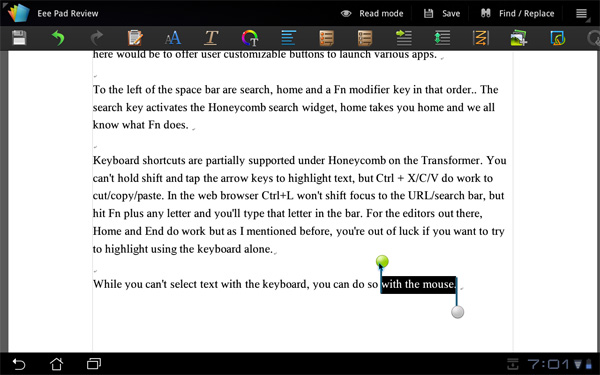

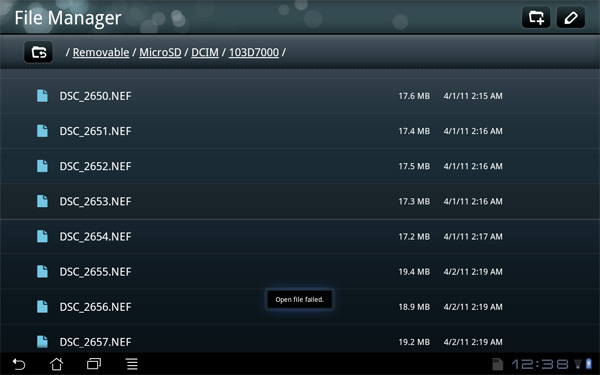








127 Comments
View All Comments
Elrondolio - Thursday, April 21, 2011 - link
None of these shots are exactly close... even something as exotic as the Noktor 50 f/0.95 (in practice, a somewhat pedestrian lens up to f/2 or so) can focus in far closer than the shots, around 2". Its certainly possible these were taken north of f/2, but the bokeh on them is very nice (north of 7 blades, I'd expect).whiteonline - Thursday, April 21, 2011 - link
I don't know. Looks like a bit of post processing effects. Look at the last photo with the power cable; the focus is a horizonal line, not radial. And very sharply changes between in and out of focus.strikeback03 - Wednesday, April 27, 2011 - link
as he has mentioned having Nikon SLRs in the past, I checked the minimum focus distance for 50 and 85mm lenses available for Nikon at B&H. The 50s are all in the 45-50cm range, and the 85s are 85-100cm.Yes I would expect the lens does was designed for nice bokeh (curved aperture blades, etc)
MrCromulent - Thursday, April 21, 2011 - link
I guess 720p and 1080p playback via HDMI won't be a problem anymore for Honeycomb tablets, will it?IronPalm - Thursday, April 21, 2011 - link
I ordered this tablet just see how well I can use flash based dashboards on it, I then saw a Xoom and was wondering if I should cancel my order.Compared to what I've read recently this review was done well, a refreshing change, as others have said a great review.
Now the only thing i'm wondering is how the user experience compares to an ipad (e.g. the touch sensitivity etc). I noticed there was a bit of lag on the Xoom, but I haven't noticed that playing with display ipad's in tech stores.
I hope this isn't a repeat of an earlier episode in my life...I wanted an iPhone, but didn't really want one, so I got one for my wife. After playing with it (to update software of course) I was impressed by the touch screen. My resistive WM 6.5 didn't cut after that. I dropped it by accident around the time when the HTC HD2 came out with it's capacitive touch screen, great I though, just what I'd been looking for. Unfortunately not all capacitive touch screens are equal.
kmmatney - Friday, April 22, 2011 - link
The iPad does have flash, to some degree:http://www.engadget.com/2011/03/10/ipad-gets-flash...
don't know if a flash-based apps would work, though
Wanderer200 - Thursday, April 21, 2011 - link
Very nice extended review, thumbs up!but i was wondering about one thing:
"The price point alone is enough to make the Eee Pad the Honeycomb tablet to get assuming you don't need integrated GPS"
Because on the Asus website the specs say is does have GPS and in other review i saw google maps in action... so i assume is does have GPS?
I also read about the firmware upgrade wich is downloadable right now, it fixxes some of the issues you encountered with the transformer (like the camera green screen) did you try to upgrade your firmware?
Anand Lal Shimpi - Thursday, April 21, 2011 - link
I've corrected the review - GPS hardware is present in the Eee Pad Transformer, although some apps require that you are actively connected via WiFi in order to use GPS.I updated the firmware on our review sample, however there are apparently one or two more revisions left before systems go on sale next week. I should have updated software soon.
Take care,
Anand
jbh129 - Thursday, April 21, 2011 - link
At this point, there is no legitimate reason to buy a tablet that is not an iPad.eddman - Thursday, April 21, 2011 - link
Steve, is that you?